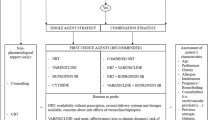Abstract
Smoking cessation should be proposed to all smokers by healthcare workers; however, severely dependent smokers are frequently unable or unwilling to quit smoking. For some of them, particularly if they have failed in previous cessation attempts and have smoking-related disorders, a long term reduction of tobacco consumption may be proposed as the ‘second best’ attitude and may offer a perspective for reduction of some of the risk factors associated with smoking. This attitude, which cannot be regarded as a general health policy, usually requires the prolonged use of nicotine replacement therapy. From available studies, it does not seem that a period of sustained smoking reduction decreases the chance of future cessation, it may even increase it.
Similar content being viewed by others
References
Warner KE, Slade J, Sweanor DT. The emerging market for long-term nicotine maintenance. JAMA 1997; 278: 1087–92
Levi F, Franceschi S, La Vecchia C, et al. Lung carcinoma trends by histologic type in Vaud and Neuchatel, Switzerland, 1974–1994. Cancer 1997; 79(5): 906–14
Leavell NR. The low tar lie. Tob Control 1999; 8: 433–7
Rennard SI, Daughton D, Fujita J, et al. Short-term smoking reduction is associated with reduction in measures of lower respiratory tract inflammation in heavy smokers. Eur Respir J 1990; 3: 752–9
Bolliger CT, Zellweger JP, Danielsson T, et al. Effectiveness of the nicotine inhaler in smoking reduction. Am J Respir Crit Care Med 1999; 159 (3 Pt 2): A735
Hurt RD, Croghan GA, Walter TD, et al. Does smoking reduction result in reduction of biomarkers associated with harm? A pilot study using nicotine inhaler. Nicotine Tobacco Res 2000; 2: 327–36
Anthonisen NR, Connet JE, Kiley JP, et al. Effects of smoking intervention and the use of an inhaled anticholinergic bronchodilator on the rate of decline of FEV 1 The lung health study. JAMA 1994; 272: 1497–505
Windsor RA, Boyd NR, Orleans CT. A meta-evaluation of smoking cessation intervention research among pregnant women: improving the science and the art. Health Educ Res 1998; 13(3): 419–38
National Cancer Institute. Changes in cigarette-related disease risk and their implication for prevention and control. NIH publication 1997; 97–4213
Jimenez-Ruiz C, Kunze M, Fagerstrom KO. Nicotine replacement: a new approach to reducing tobacco-related harm. Eur Respir J 1998; 11: 473–9
Hughes JR, Cummings M, Hyland A. Ability of smokers to reduce their smoking and its association with future smoking cessation. Addiction 1999; 94: 109–14
Bolliger CT, Zellweger JP, Danielsson T, et al. Smoking reduction with oral nicotine inhalers: double blind, randomized clinical trial of efficacy and safety. BMJ 2000; 321: 329–3
Dalack GW, Meador-Woodruff JH. Acute feasibility and safety of a smoking reduction strategy for smokers with schizophrenia. Nicotine Tob Res 1999; 1: 53–7
Jimenez-Ruiz C, Kunze M, Fagerstrom KO. Efficacy and safety of nicotine gum in smoking reduction: a double-blind, randomized, placebo-controlled study. Eur Resp J 2000. In press
Fagerstrom KO. Aiding reduction of smoking with nicotine replacement therapy: hope for the recalcitrant smoker? Tob Control 1997; 6: 311–6
Pickworth WB, Bunker EB, Henningfield JE. Transdermal nicotine: reduction of smoking with minimal abuse liability. Psychopharm 1994; 115: 9–14
Farkas AJ. When does cigarette fading increase the likelihood of future cessation? Ann Behav Med 1999; 21: 71–6
Parrott S, Godfrey C, Raw M, et al. A guidance for commissioners on the cost effectiveness of smoking cessation interventions. Thorax 1998; 53 Suppl. 5 (Pt 2): S1–38
DiClemente CC, Prochaska JO, Fairhurst SK, et al. The process of smoking cessation: an analysis of precontemplation, contemplation and preparation stages of change. J Clin Consult Psychol 1991; 59: 295–304
Author information
Authors and Affiliations
Corresponding author
Rights and permissions
About this article
Cite this article
Zellweger, JP. Anti-Smoking Therapies. Drugs 61, 1041–1044 (2001). https://doi.org/10.2165/00003495-200161080-00001
Published:
Issue Date:
DOI: https://doi.org/10.2165/00003495-200161080-00001




